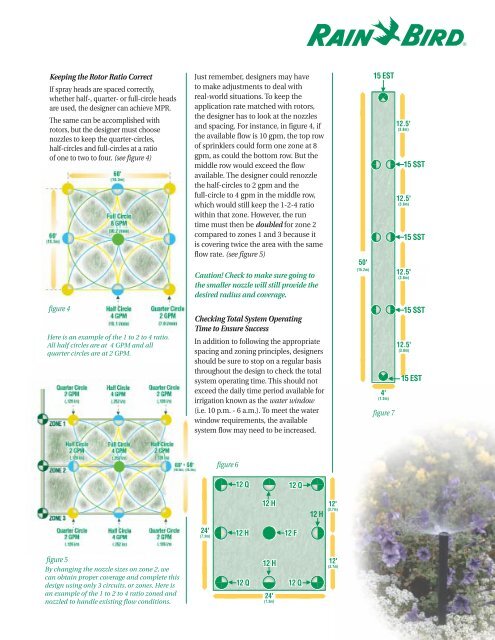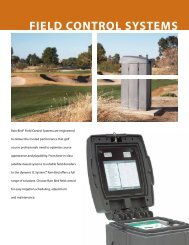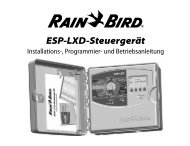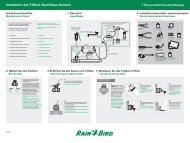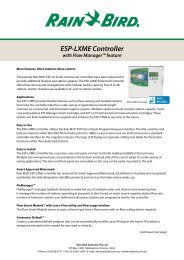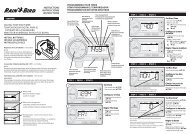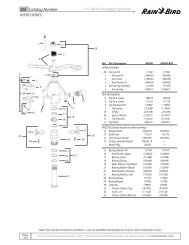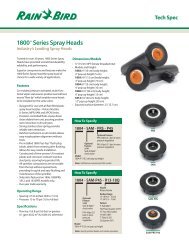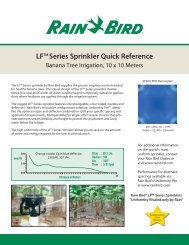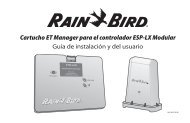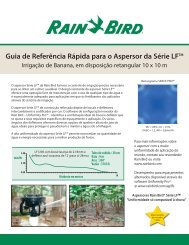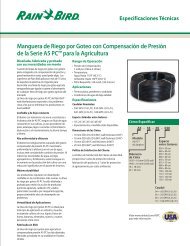Sprinkler Spacing and Design - Rain Bird
Sprinkler Spacing and Design - Rain Bird
Sprinkler Spacing and Design - Rain Bird
You also want an ePaper? Increase the reach of your titles
YUMPU automatically turns print PDFs into web optimized ePapers that Google loves.
Keeping the Rotor Ratio Correct<br />
If spray heads are spaced correctly,<br />
whether half-, quarter- or full-circle heads<br />
are used, the designer can achieve MPR.<br />
The same can be accomplished with<br />
rotors, but the designer must choose<br />
nozzles to keep the quarter-circles,<br />
half-circles <strong>and</strong> full-circles at a ratio<br />
of one to two to four. (see figure 4)<br />
figure 4<br />
Here is an example of the 1 to 2 to 4 ratio.<br />
All half circles are at 4 GPM <strong>and</strong> all<br />
quarter circles are at 2 GPM.<br />
figure 5<br />
By changing the nozzle sizes on zone 2, we<br />
can obtain proper coverage <strong>and</strong> complete this<br />
design using only 3 circuits, or zones. Here is<br />
an example of the 1 to 2 to 4 ratio zoned <strong>and</strong><br />
nozzled to h<strong>and</strong>le existing flow conditions.<br />
Just remember, designers may have<br />
to make adjustments to deal with<br />
real-world situations. To keep the<br />
application rate matched with rotors,<br />
the designer has to look at the nozzles<br />
<strong>and</strong> spacing. For instance, in figure 4, if<br />
the available flow is 10 gpm, the top row<br />
of sprinklers could form one zone at 8<br />
gpm, as could the bottom row. But the<br />
middle row would exceed the flow<br />
available. The designer could renozzle<br />
the half-circles to 2 gpm <strong>and</strong> the<br />
full-circle to 4 gpm in the middle row,<br />
which would still keep the 1-2-4 ratio<br />
within that zone. However, the run<br />
time must then be doubled for zone 2<br />
compared to zones 1 <strong>and</strong> 3 because it<br />
is covering twice the area with the same<br />
flow rate. (see figure 5)<br />
Caution! Check to make sure going to<br />
the smaller nozzle will still provide the<br />
desired radius <strong>and</strong> coverage.<br />
Checking Total System Operating<br />
Time to Ensure Success<br />
In addition to following the appropriate<br />
spacing <strong>and</strong> zoning principles, designers<br />
should be sure to stop on a regular basis<br />
throughout the design to check the total<br />
system operating time. This should not<br />
exceed the daily time period available for<br />
irrigation known as the water window<br />
(i.e. 10 p.m. - 6 a.m.). To meet the water<br />
window requirements, the available<br />
system flow may need to be increased.<br />
24'<br />
(7.3m)<br />
figure 6<br />
12 Q<br />
12 H<br />
12 H<br />
12 H<br />
12 F<br />
12 Q 12 Q<br />
24'<br />
(7.3m)<br />
12 Q<br />
12 H<br />
12'<br />
(3.7m)<br />
12'<br />
(3.7m)<br />
50'<br />
(15.2m)<br />
15 EST<br />
4'<br />
(1.2m)<br />
figure 7<br />
12.5' 35'<br />
(10.67m) (3.8m)<br />
12.5' 35'<br />
(10.67m) (3.8m)<br />
15 SST<br />
15 SST<br />
12.5' 35'<br />
5004-PC 5004-P<br />
(10.67m) (3.8m) 6.0 GPM (22. (22.8 l/min)<br />
Half Circ Circle<br />
15 SST<br />
12.5' 35'<br />
(10.67m) (3.8m)<br />
15 EST


